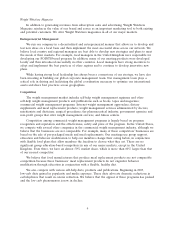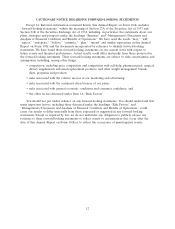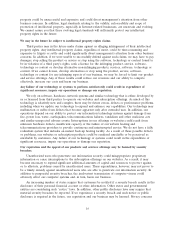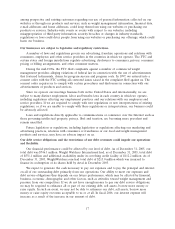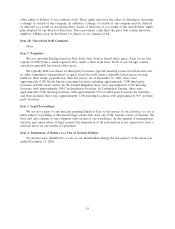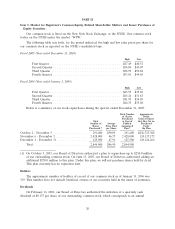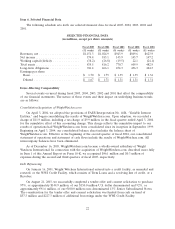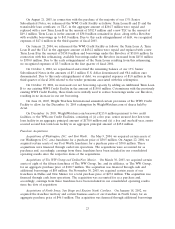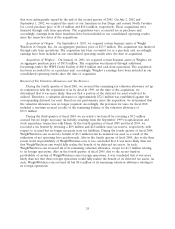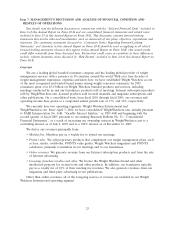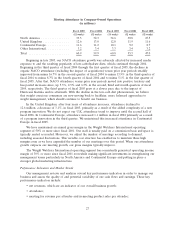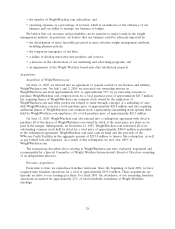WeightWatchers 2005 Annual Report Download - page 28
Download and view the complete annual report
Please find page 28 of the 2005 WeightWatchers annual report below. You can navigate through the pages in the report by either clicking on the pages listed below, or by using the keyword search tool below to find specific information within the annual report.Our credit facilities contain customary covenants, including covenants that in certain circumstances
restrict our ability to incur additional indebtedness, pay dividends on and redeem capital stock, make
other restricted payments, including investments, sell our assets and enter into consolidations, mergers
and transfers of all or substantially all of our assets. Our credit facilities also require us to maintain
specified financial ratios and satisfy financial condition tests, certain of which become more restrictive
under WeightWatchers.com’s credit facilities over time. Our ability to meet those financial ratios and
tests can be affected by events beyond our control and we cannot assure you that we will meet those
ratios and tests. A breach of any of these covenants, ratios, tests or restrictions could result in an event
of default under the credit facilities. If an event of default exists under the credit facilities, the lenders
could elect to cease making loans and declare all amounts outstanding thereunder to be immediately
due and payable. If the lenders under the credit facilities accelerate the payment of the indebtedness,
our assets may not be sufficient to repay in full that indebtedness and our other indebtedness that
would become due as a result of any acceleration.
Artal controls us and may have conflicts of interest with other shareholders in the future.
Artal controls us and is able to control the election and removal of our directors and determine
our corporate and management policies, including potential mergers or acquisitions, payment of
dividends, asset sales, the amendment of our articles of incorporation or bylaws and other significant
corporate transactions. This concentration of our ownership may delay or deter possible changes in
control of our company, which may reduce the value of an investment in our common stock. Even if
Artal beneficially owns less than 50% but 10% or more of our common stock, Artal will have the right
pursuant to an agreement with us to nominate directors to our Board of Directors in proportion to its
stock ownership. The interests of Artal may not coincide with the interests of other holders of our
common stock.
We are a ‘‘controlled company’’ within the meaning of the New York Stock Exchange rules and, as a
result, qualify for exemptions from certain corporate governance requirements.
Artal controls a majority of the voting power of our outstanding common stock. Under the New
York Stock Exchange rules, a listed company of which more than 50% of the voting power is held by
another person or group of persons acting together is a ‘‘controlled company’’ and such a company may
elect not to comply with certain New York Stock Exchange corporate governance requirements,
including (1) the requirement that a majority of the Board of Directors consist of independent
directors, (2) the requirement that the nominating and corporate governance committee be composed
entirely of independent directors with a written charter addressing the committee’s purpose and
responsibilities, (3) the requirement that the compensation committee be composed entirely of
independent directors with a written charter addressing the committee’s purpose and responsibilities
and (4) the requirement for an annual performance evaluation of the nominating and corporate
governance and compensation committees. We have elected to be treated as a ‘‘controlled company’’.
Accordingly, our shareholders may not have the same protections afforded to shareholders of
companies that are subject to all of the New York Stock Exchange corporate governance requirements.
Our articles of incorporation and bylaws and Virginia corporate law contain provisions that may
discourage a takeover attempt.
Provisions contained in our articles of incorporation and bylaws and the laws of Virginia, the state
in which we are incorporated, could make it more difficult for a third party to acquire us, even if doing
so might be beneficial to our shareholders. Provisions of our articles of incorporation and bylaws
impose various procedural and other requirements, which could make it more difficult for shareholders
to effect certain corporate actions. For example, our articles of incorporation authorize our Board of
Directors to determine the rights, preferences, privileges and restrictions of unissued series of preferred
stock, without any vote or action by our shareholders. Thus, our Board of Directors can authorize and
issue shares of preferred stock with voting or conversion rights that could adversely affect the voting or
18



